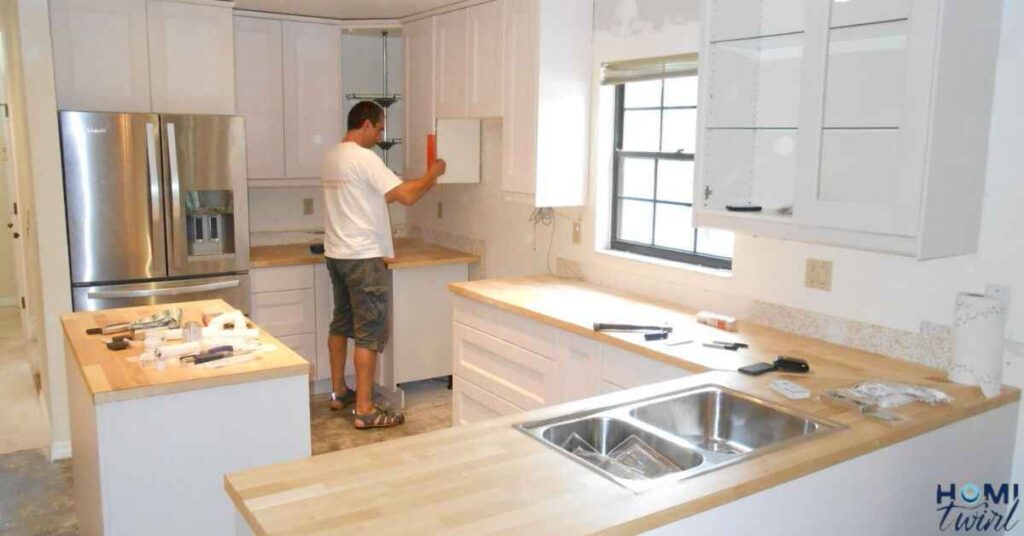Embarking on a kitchen renovation project is an exciting endeavor, but it’s crucial to have a realistic understanding of the time frame involved, particularly when it comes to installing kitchen cabinets.
Whether you’re aiming for a complete kitchen makeover or a simple update, knowing the time required for kitchen cabinet installation can help you plan effectively and set reasonable expectations.
Basics of Kitchen Cabinet Installation
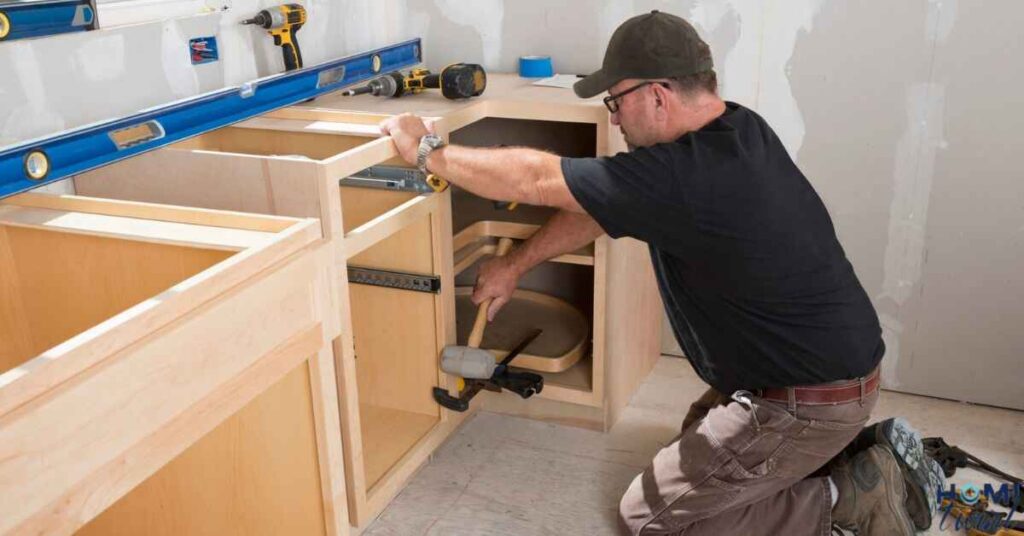
Before we delve into the nitty-gritty of installation timelines, let’s briefly explore the essence of kitchen cabinet installation. This process is a critical component of any kitchen remodeling project, as cabinets not only provide essential storage solutions but also contribute significantly to the overall aesthetic appeal and functionality of your culinary space.
Read This Blog: HOW LONG DO KITCHEN CABINETS LAST
Installing kitchen cabinets involves a series of intricate steps, from precise measurements and layout planning to the actual installation of base and wall cabinets, followed by the addition of finishing touches like hardware and countertops. It’s a process that demands meticulous attention to detail and a thorough understanding of the specific requirements of your kitchen space.
How Long Does It Take to Install Kitchen Cabinets?
The duration of the installation process can vary significantly depending on several key factors. While some projects may be completed in a matter of days, others may span over a week or even longer. It’s essential to consider these variables to ensure accurate kitchen renovation duration estimation.
Factors Affecting Duration
- Type of Cabinets: The cabinet type you choose – whether stock, semi-custom, or fully custom – can significantly impact the installation timeline. Stock cabinets, which are pre-made and readily available, typically require less time for installation compared to semi-custom or custom cabinets that involve more customization and precise fitting.
- Size of the Kitchen: The larger your kitchen space, the more cabinets it will likely require, resulting in an extended installation time. Conversely, smaller kitchens may be completed more quickly.
- Complexity of Design: Kitchens with intricate designs, featuring elements like corner cabinets, pull-out drawers, or intricate hardware, tend to demand more installation time due to their inherent complexity.
- Level of Preparation Required: If your kitchen requires extensive preparation work, such as wall repairs, removal of old cabinets, or adjustments to plumbing and electrical systems, these tasks will add to the overall kitchen remodeling timeline.
- Professional vs. DIY Installation: Hiring professional installers can often expedite the process due to their experience and efficiency. However, if you opt for a DIY approach, the installation time may be extended, especially if you’re learning as you go.
Average Time Estimates
While it’s challenging to provide a one-size-fits-all timeframe, here are some general estimates to give you an idea of the installation of kitchen cabinets.
- Stock Cabinets: For a medium-sized kitchen, professional installation might take anywhere from 1 to 2 days.
- Semi-Custom and Custom Cabinets: These can take several days to a week or longer, depending on the complexity and extent of customization required.
- DIY Projects: DIY installations can vary widely in terms of time, potentially spanning multiple weekends or evenings over several weeks, especially if you’re new to the process.
It’s important to note that these are rough estimates, and your specific project may deviate from these timelines based on the unique factors mentioned above.
Installation Tips For Kitchen Cabinets
Whether you’re tackling a DIY kitchen renovation or working with professionals, there are several tips that can help ensure a smooth and efficient installation process.
Planning and Measurement
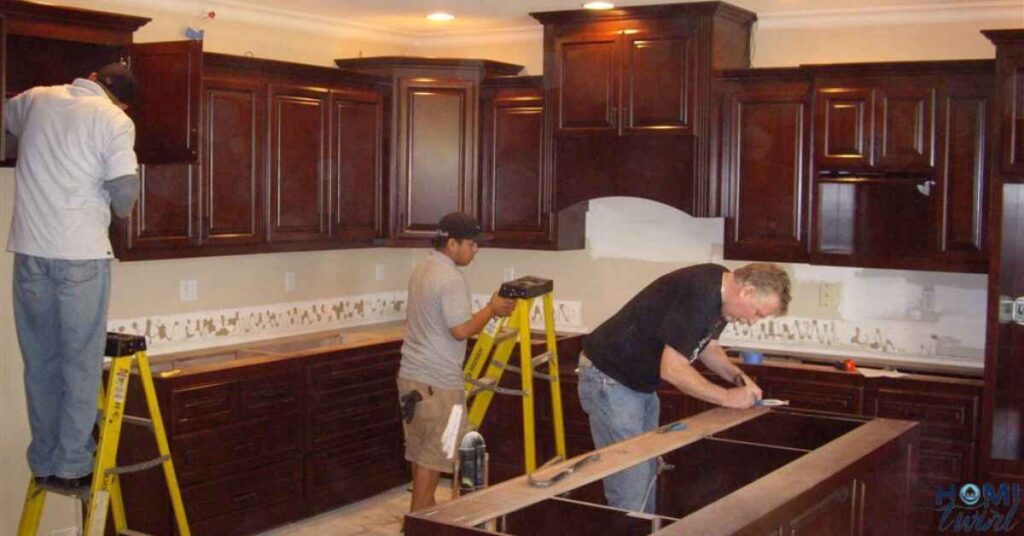
Proper planning and precise measurements are the foundations of a successful cabinet installation. Here are some key steps.
Also Read This Blog: CAN YOU REPLACE COUNTERTOPS WITHOUT REPLACING CABINETS
- Design Layout: Start by planning the layout of your kitchen, considering the placement of appliances, windows, and doors. You can use graph paper or digital kitchen planning tools for added precision.
- Accurate Measurements: Measure the dimensions of your kitchen walls, windows, and doorways meticulously. Don’t forget to account for any obstacles like pipes or electrical outlets that may impact the cabinet placement.
Selecting Cabinets
Choosing the right type of cabinets is crucial for achieving your desired aesthetic and functional goals. Consider the following.
- Cabinet Types: Decide between stock, semi-custom, or custom cabinets based on your budget, design preferences, and the unique characteristics of your kitchen space.
- Material and Style: Select cabinet materials and styles that complement the overall design of your kitchen while ensuring durability and longevity.
Preparation
Proper preparation is key to ensuring a smooth installation process. Here are some essential steps.
- Removal of Old Cabinets: If you’re replacing existing cabinets, carefully remove them and clear the area, ensuring a clean slate for the new installation.
- Prepare Tools and Materials: Gather all necessary tools and hardware in advance, such as a level, drill, screws, and a stud finder, to avoid any delays during the installation process.
Installation Process
Once the planning and preparation stages are complete, it’s time to dive into the installation itself. Here’s a general overview of the steps involved.
- Mark Reference Lines: Use a level to draw horizontal lines on the walls where the base and wall cabinets will be aligned. These reference lines will ensure a level and consistent installation.
- Install Wall Cabinets First: It’s generally easier to hang the upper cabinets before the base cabinets obstruct your movement and access.
- Secure Cabinets to Wall Studs: Use a stud finder to locate the studs in the wall, and securely attach the cabinets to these studs using screws for optimal stability.
- Install Base Cabinets: Ensure the base cabinets are level and aligned with your reference lines. Adjust the legs or use shims if necessary to achieve a perfect fit.
- Align and Join Cabinets: As you install each cabinet, ensure they are aligned flush with each other. Use clamps to hold them together temporarily, and then join them using screws for a secure connection.
Finishing Touches
Once the cabinets are in place, it’s time to add the final touches that will complete the installation process.
- Install Doors and Hardware: Attach the cabinet doors, drawers, and hardware according to the manufacturer’s instructions.
- Sealing and Caulking: Seal any gaps between the wall and cabinets with caulk for a polished, seamless look.
Safety and Precision
Throughout the installation process, it’s crucial to prioritize safety and precision. Take the necessary precautions, such as using proper lifting techniques and following safety protocols. Maintaining precision in measurements and alignment will ensure a seamless and visually appealing final result.
Creating an Installation Schedule for Kitchen Cabinets
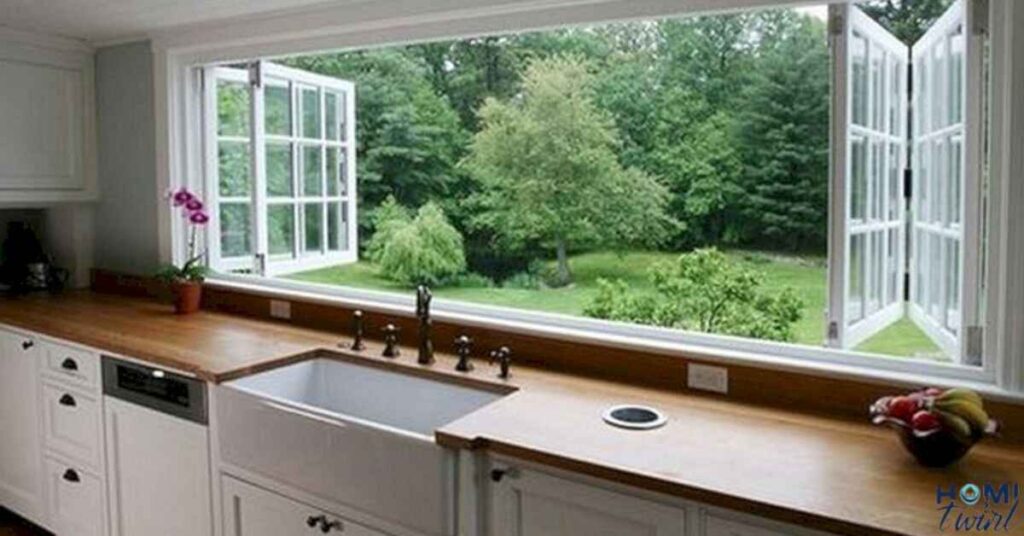
Developing a well-structured installation schedule for kitchen cabinets is key to ensuring the process is smooth, efficient, and free of unnecessary delays. A schedule not only helps in managing time effectively but also provides a clear roadmap for the project, whether you’re working with professionals or tackling the installation yourself.
Initial Assessment and Measurements (1-2 Days)
Before any work begins, accurately measure your kitchen space. This phase involves.
- Measuring the dimensions of your kitchen.
- Deciding on the layout and type of cabinets.
- Identifying any potential issues, like uneven walls or floors, that may need addressing.
Ordering and Delivery of Cabinets (Varies)
The time it takes to receive your cabinets depends on whether you choose stock, semi-custom, or custom options.
- Stock Cabinets: Usually available immediately or within a few days.
- Semi-Custom and Custom Cabinets: These can take several weeks to months to be delivered, depending on the manufacturer and the level of customization required.
Preparation Work (1-3 Days)
Preparing your kitchen for new cabinets typically involves.
- Removing old cabinets and fixtures.
- Repairing and prepping walls and floors, and possibly rerouting utilities.
- Ensuring the space is clean and ready for installation.
Actual Installation (2-7 Days)
This is the core phase where the cabinets are installed.
- Day 1-2: Start with base cabinets, ensuring they are level and securely attached.
- Day 3-4: Install wall cabinets, following the same precision as with base cabinets.
- Day 5-7: If you have a large kitchen or complex designs, additional days might be required. This time is also used for installing crown molding, toe kicks, and hardware.
Post-Installation Finishing Touches (1-2 Days)
After the cabinets are in place, focus on:
- Adjusting doors and drawers for perfect alignment.
- Installing countertops (if not done already), which might require professional
Post-Installation Finishing Touches (1-2 Days)
After the cabinets are in place, focus on.
- Adjusting doors and drawers for perfect alignment.
- Installing countertops (if not done already), which might require professional assistance.
- Final clean-up and inspection of the installation.
Contingency Time (1-2 Days)
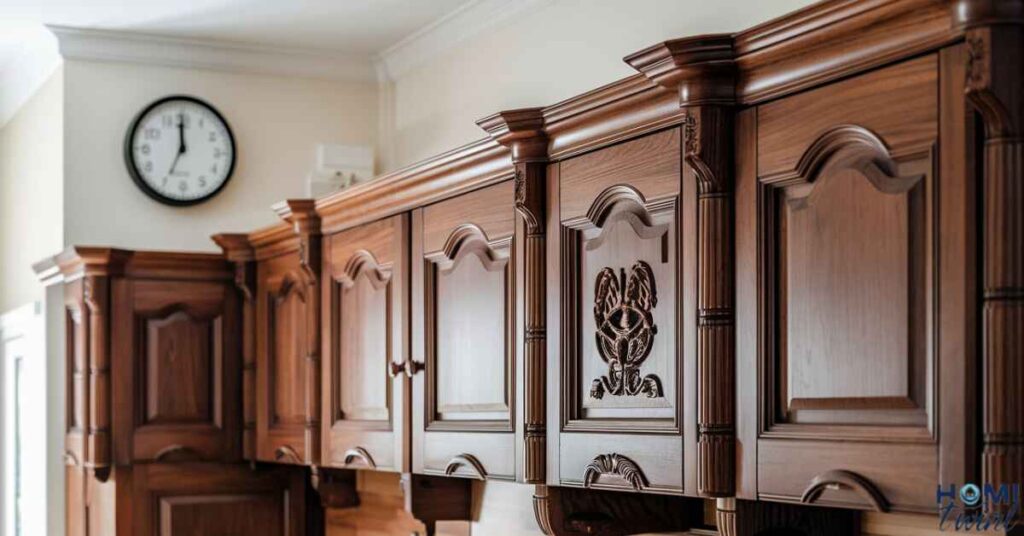
It’s wise to allocate some extra time to address any unexpected challenges or delays that might arise during the installation process. Unforeseen circumstances, such as delivery delays, hardware issues, or the need for additional repairs, can potentially extend the kitchen remodeling timeline.
By establishing a clear schedule and allowing for flexibility, you can navigate the installation process with greater ease and efficiency. Remember, thorough planning and preparation are the keys to a successful kitchen cabinet installation.
Case Study: The Johnsons’ Kitchen Renovation
To illustrate the importance of proper planning and realistic timelines, let’s consider the case of the Johnson family, who recently embarked on a kitchen renovation project.
The Johnsons opted for custom cabinets to perfectly fit their unique kitchen layout. After consulting with a professional contractor, they were informed that the entire installation process could take approximately three weeks, factoring in the delivery time for the custom cabinets and the complexity of their design.
Initially, the Johnsons were taken aback by the extended timeline, but their contractor provided a detailed breakdown of the schedule.
- Initial Assessment and Measurements: 2 days
- Ordering and Delivery of Custom Cabinets: 3-4 weeks
- Preparation Work: 3 days
- Actual Installation: 5 days
- Post-Installation Finishing Touches: 2 days
- Contingency Time: 2 days
By understanding the breakdown of tasks and allowing for contingencies, the Johnsons were able to plan accordingly and set realistic expectations for their kitchen makeover timeframe.
“Having a clear timeline and understanding the reasoning behind each phase made the entire process much more manageable,” said Mrs. Johnson. “It helped us prepare mentally and logistically, and we were able to coordinate our daily routines around the renovation schedule.
The Johnson family’s experience highlights the importance of open communication, detailed planning, and realistic timelines when undertaking a significant kitchen renovation project.
FAQs
How much does it typically cost to install kitchen cabinets?
The cost of installing kitchen cabinets can vary significantly depending on factors like the cabinet type, kitchen size, and whether you hire professionals or opt for a DIY approach. Prices can range from a few thousand dollars for basic stock cabinets to much higher for custom designs and professional installation.
Can I install kitchen cabinets myself?
Yes, you can certainly tackle a DIY kitchen cabinet installation if you have the necessary skills and tools. However, it’s crucial to have some prior home improvement experience and a willingness to dedicate the time and precision required for a successful installation.
How do I know if my kitchen is ready for cabinet installation?
Your kitchen is ready for cabinet installation when any old cabinets have been removed, walls are prepped and repaired if necessary, and measurements have been confirmed. Additionally, ensure that plumbing and electrical systems are correctly aligned with the new cabinet layout.
How long do kitchen cabinets last?
The lifespan of kitchen cabinets can vary greatly depending on the quality of materials, construction, and maintenance. Generally, high-quality kitchen cabinets can last anywhere from 10 to 50 years with proper care and maintenance.
Are custom cabinets worth the extra cost?
Custom cabinets offer unparalleled flexibility in design and can perfectly fit the unique dimensions of your kitchen space. While they come with a higher price tag, they can be an excellent investment if you have specific design needs or a kitchen layout that requires custom solutions.
Concluding Remarks
Installing kitchen cabinets is a significant but manageable component of any kitchen remodeling project. By understanding the factors that influence the duration of the installation process, such as cabinet type, kitchen size, design complexity, and preparation work required, you can set realistic expectations and plan accordingly.
Whether you opt for a professional installation or a DIY approach, following a well-structured schedule, maintaining open communication, and allowing for contingencies can help ensure a smooth and efficient experience.
Remember, a successful kitchen cabinet installation not only enhances the functionality and aesthetics of your kitchen but also contributes to the overall value and enjoyment of your living space. With proper planning, patience, and attention to detail, you can navigate this process confidently and achieve the kitchen of your dreams.

